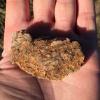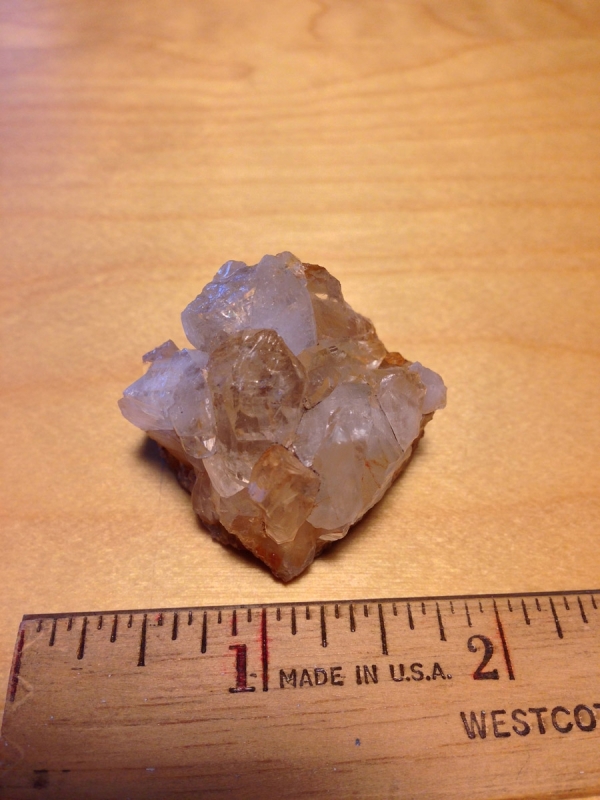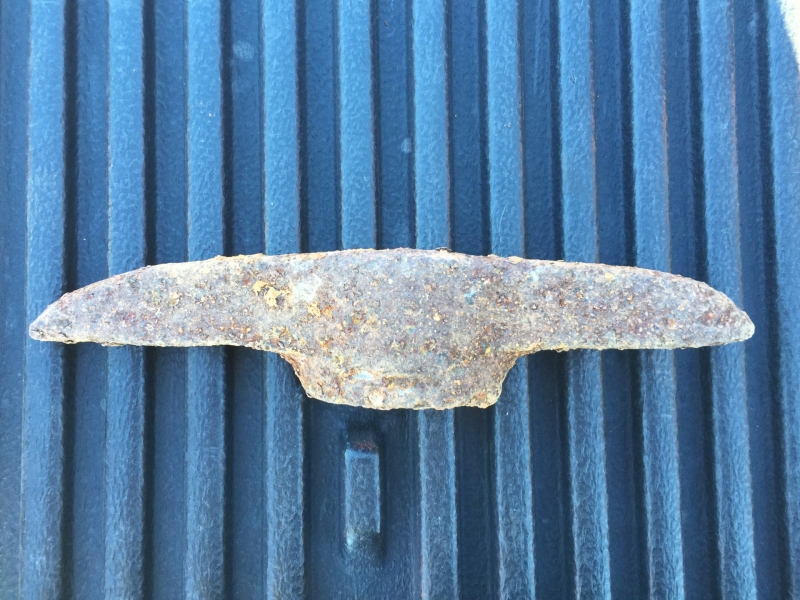-
Posts
304 -
Joined
-
Last visited
Content Type
Forums
Detector Prospector Home
Detector Database
Downloads
Posts posted by Tortuga
-
-
2 hours ago, Blackcoffee said:
Rookie question- what do you mean by "pothole"?
"searching for a patch" what are some key features of likely looking spots in your neighborhood?
A pothole is an old hole, looks kinda like a crater, that the oldtimers dug up. They usually dug down to bedrock then drywashed the paydirt. Over the years the hole will get filled in by erosion and they can look like a small depression or crater.
In Arizona all the patches I've found have had some old workings around them. My patches have mostly consisted of working a few more nuggets out of areas the oldtimers dug or places hunted by detectorists in the past with older tech or less skill. Anything over 5-6 nuggets in a small area I'll consider a patch.
Like I said I look for old workings and importantly for where I hunt, red clay. But each goldfield is different.
-
Exploration for me still consists of looking for old workings and potholes. Here in Arizona I'm pretty confident I know what the geology should look like for undiscovered nugget patches but time is always a big constraint for me. Down the road once I'm retired or something and I've got a nice cache of gold and I've got the time I'll probably get more into exploration and see if I can reap the rewards from that. For now I just stick to where it's already been found and try to eek out a few more that were missed.
-
I purchased a Walco from this Australian dealer but the shipping wasn't cheap- http://goldsearchaustralia.com
But a good pick is important to me. The next best thing might be to contact Ivan and have him make you a Walco pattern pick with the nice round handles they have. Should be cheaper than paying for shipping from Australia for a real Walco.
-
I've always liked Walco the best but they're hard to find.
Apex makes a tough pick but I always felt the handle was a little too "fat" and the heads are pretty heavy on them. I don't care for the dinky magnets they stick on them either. I buy pretty large neodymium magnets online that I stick on my picks.
-
Just not sure if it's worth buying (30% more depth). Not a big fan of the open coil design either.
-
Well atleast you've found some in the past and broken that barrier. A lot of guys give up after a year or two after hunting and not finding that first one. Atleast you know what a nugget sounds like, which is important.
When I start getting frustrated, thinking to myself "what am I doing here..." I try to think how all week long at work all I was thinking about was getting out and detecting again so I use that for motivation to push onward.
-
What area are you hunting?
If you're in gold country and you're surrounded by old diggings you already know it's there in the ground. Don't try to cover miles and miles of country. Just slow down and be more through and methodical than the guys that came before you. Have confidence in your detector and yourself and work small areas. Spend an hour or a day in one small 20x20 foot area or a couple old potholes or a drainage.
Poke your coil under tough brush or trees and kick some rocks outta the area. If you start finding trash that's GOOD because that was stuff left behind or ignored by others and dig all targets!
-
As far as other noises the GPZ makes I've tuned my ear to a distinct 'broken chatter' most .22 slugs will always sound like. Birdshot gives me a quiet tone like a nugget at first but once in the scoop stays a quiet tone.
And is it me or does gold, along with the high-low signal, seem to give off a higher, faster pitch than iron targets? Nuggets are typically a mellow, quite tone when I first swing over them but once I dig further down or get the nugget in my scoop my GPZ just seems to be "singing" in a lot higher pitch. I lend this to either Minelab metallurgy programming or just the uncommon high-low signal (most of my targets are low-high iron rubbish so that's what I'm more used to hearing).
-
I'd probably buy the top of Rich Hill with that kinda money and scrape about 15 feet off the whole thing!
-
I love the look of water worn, uncut alluvial gemstones. Need to pick up an alluvial topaz or something at the gem show one of these days. So cool how you can actually feel the weight of a gemstone compared to just a plain rock that's the same size.
Like Steve said Fistfuls of Gold is a great read. It took me a while to finish it, was slow getting through some of the hardrock chapters etc. but I wanted to read the whole thing.
Most other books out there just have brief chapters on nuggetshooting (look for bedrock) or aren't really up to date on some of the newer metal detecting technologies. 'Fistfuls' pretty much sets the bar covering all aspects of gold prospecting that you'd need to know about.
-
If it was me I wouldn't touch it, just keep it like nature intended. Gives it more character and you get to relive the discovery every time you look at it. A little soap and water is all my nuggets get to get some of the clay off.
-
Great looking nugget.
-
Thanks guys
-
On April 26, 2016 at 3:50 PM, goldenoldie said:
Thanks RDD for your reply and the pic of your nugget.
Unfortunately Iron and Steel produce a better response than Gold.
I know you're right but isn't gold denser and more conductive?
Does it have something to do with iron and steel being refined metals or maybe just how they're found? Considering if a nugget is still "in situ" and not sitting in an old tailing pile or pothole, it can very be ancient and may have occupied a bedrock crack or clay bar for thousands of years. It should have a lot more clay and soil built up around it than a piece of iron or steel dropped or tossed 50-100 years ago. Maybe that's why manmade trash targets are typically louder and don't have that soft, quiet tone like some gold nuggets.
-
Ok gotcha. The places I hunt in AZ aren't known for their quartz crystals like that. Interesting.
-
Do the quartz crystals have anything to do with gold nugget formation?
I know a hillside here in Arizona where I've found tons of clear, almost gem quality iron-stained quartz crystals all over the ground.
Found a small Japanese twin there once.
There was a little bit of chrysocolla and agate there too.
I don't recall lots of ironstones, schist and greenstone like the rest of the minerals we find in the goldfields down here tho.
-
I've only had experience hunting drywash tailing piles here in Arizona and I've had pretty good luck with them using my GPZ. I found a nice "pebble" specimen that weighed a few grams that I'm assuming was too spongy and deep for VLFs and PIs in the past because this was a pounded area. The GPZ is the king of specimen gold.
I've had other luck in drywash piles with the GPZ on tiny gold nuggets that were too deep and small for other detectors.
My favorite experience is finding a really old drywash pile that no one else knew was a drywash pile because it was flattened and covered by a layer of dirt. It won't be the typical pile of pebbles. I've made some nice finds in situations like that. I'll hear a target and start digging and once I'm thru the first few inches of soil it's nothing but pebbles and I know I'm on an old, hidden tailings pile.
-
Right when my $50 skid plate wears out (the black one) they announce a new coil.
Can't wait for the 19" coil to show up so gotta bite the bullet and order another skid plate from Rob....
Expensive hobby.
-
Looks like you're back in the gold! Nice.
-
I have a few cheap AWS scales but after the last one broke I spent a little coin and got a Tanita. Made in Japan (not China) and very accurate.
-
-
9 hours ago, nvchris said:
Yep, It's not uncommon for the signal to cut in and out.
I think it's a much cleaner tone when plugged in directly.
I use a short (12") jumper cable to mitigate the problems Klunker described.
Never used my GPZ without the wireless module.
Next time I'm out I might have to see if the audio is improved by plugging directly in.
-
Wow that's some really nice gold, you had a great trip.
Your partner knows the secret, go low and slow, keep the coil down and take your time.
-
Hard to tell what's in the little cracks if that's what you're asking about. Could just be clay. Give it a good cleaning with dishsoap and a toothbrush and it should be fairly obvious.





Just When I Think I Got It All
in Detector Prospector Forum
Posted
Nice gold. I need to get around to trying those settings one of these days.